|
Size: 32114
Comment:
|
Size: 48344
Comment: no xrange
|
| Deletions are marked like this. | Additions are marked like this. |
| Line 115: | Line 115: |
| else: print 'NaN' | else: print('NaN') |
| Line 140: | Line 140: |
| if start < 1 or end <=start: print "invalid start or end value" if n > end: print "WARNING: n is larger than the end value" |
if start < 1 or end <=start: print("invalid start or end value") if n > end: print("WARNING: n is larger than the end value") |
| Line 172: | Line 172: |
| #print x_cord, y_cord | |
| Line 183: | Line 182: |
| #print x, "=x y=", y, " num =", num | |
| Line 209: | Line 207: |
| print '(to go from x,y coords to an n, reset by setting n=0)' | print('(to go from x,y coords to an n, reset by setting n=0)') |
| Line 211: | Line 209: |
| #print 'if n =', n, 'then (x,y) =', (x_cord, y_cord) print '(x,y) =', (x_cord, y_cord), '<=> n =', find_n(x_cord, y_cord, start) print ' ' print "SW/NE line" if -y_cord<x_cord: print '4*t^2 + 2*t +', -x_cord+y_cord+start else: print '4*t^2 + 2*t +', +x_cord-y_cord+start print "NW/SE line" if x_cord<y_cord: print '4*t^2 +', -x_cord-y_cord+start else: print '4*t^2 + 4*t +', +x_cord+y_cord+start |
print('(x,y) =', (x_cord, y_cord), '<=> n =', find_n(x_cord, y_cord, start)) print(' ') print("SW/NE line") if -y_cord<x_cord: print('4*t^2 + 2*t +', -x_cord+y_cord+start) else: print('4*t^2 + 2*t +', +x_cord-y_cord+start) print("NW/SE line") if x_cord<y_cord: print('4*t^2 +', -x_cord-y_cord+start) else: print('4*t^2 + 4*t +', +x_cord+y_cord+start) |
| Line 239: | Line 236: |
| if start < 1 or end <=start: print "invalid start or end value" if n > end: print "WARNING: n is greater than end value" |
if start < 1 or end <=start: print("invalid start or end value") if n > end: print("WARNING: n is greater than end value") |
| Line 262: | Line 259: |
| print 'n =', factor(n) | print('n = {}'.format(factor(n))) |
| Line 284: | Line 281: |
| print 'Pink Curve: n^2 +', c print 'Green Curve: n^2 + n +', c2 |
print('Pink Curve: n^2 +', c) print('Green Curve: n^2 + n +', c2) |
| Line 312: | Line 309: |
| print M; print '\n'*3 print "Computing basis...\n\n" |
print(M) print('\n' * 3) print("Computing basis...\n\n") |
| Line 315: | Line 313: |
| print "Space has dimension 0" | print("Space has dimension 0") |
| Line 317: | Line 315: |
| prec = max(prec, M.dimension()+1) | prec = max(prec, M.dimension() + 1) |
| Line 320: | Line 318: |
| print "\n\n\nDone computing basis." | print("\n\n\nDone computing basis.") |
| Line 333: | Line 331: |
| print A.cuspidal_subgroup() | print(A.cuspidal_subgroup()) |
| Line 754: | Line 752: |
| print "p = %s"%p show(E.change_ring(GF(p)).plot(),xmin=0,ymin=0) |
print("p = %s" % p) show(E.change_ring(GF(p)).plot(), xmin=0, ymin=0) |
| Line 817: | Line 815: |
| c = list(continued_fraction(RealField(prec)(number))); print c | c = list(continued_fraction(RealField(prec)(number))); print(c) |
| Line 846: | Line 844: |
| L = [[-0.5, 2.0^(x/100.0) - 1 + sqrt(3.0)/2] for x in xrange(1000, -1, -1)] R = [[0.5, 2.0^(x/100.0) - 1 + sqrt(3.0)/2] for x in xrange(1000)] xes = [x/1000.0 for x in xrange(-500,501,1)] |
L = [[-0.5, 2.0^(x/100.0) - 1 + sqrt(3.0)/2] for x in range(1000, -1, -1)] R = [[0.5, 2.0^(x/100.0) - 1 + sqrt(3.0)/2] for x in range(1000)] xes = [x/1000.0 for x in range(-500,501,1)] |
| Line 872: | Line 870: |
| = Multiple Zeta Values = | = Multiple Zeta Values = |
| Line 874: | Line 872: |
| == Computing Multiple Zeta values == | == Computing Multiple Zeta values == === Word Input === |
| Line 878: | Line 877: |
| def _( weight=(7,(3..10))): | def _( weight=(5,(2..100))): |
| Line 931: | Line 930: |
| print zeta(a) }}} |
u=zeta(a) RIF=RealIntervalField(int(3.321928*D)) u=u/1 print(u) }}} {{attachment:akhi1.png}} === Composition Input === {{{#!sagecell R=RealField(10) @interact def _( Depth=(5,(2..100))): n=Depth a=[2] a=a+[1 for i in range(n-1)] @interact def _(v=('Composition', input_grid(1, n, default=[a], to_value=lambda x: vector(flatten(x)))), accuracy=(100..100000)): D=accuracy a=[v[i] for i in range(len(v))] def comptobin(a): word=[] for i in range(len(a)): word=word+[0]*(a[i]-1)+[1] return(word) a=comptobin(a) DD=int(3.321928*D)+int(R(log(3.321928*D))/R(log(10)))+4 RIF=RealIntervalField(DD) def Li(word): n=int(DD*log(10)/log(2))+1 B=[] L=[] S=[] count=-1 k=len(word) for i in range(k): B.append(RIF('0')) L.append(RIF('0')) if(word[i]==1 and i<k-1): S.append(RIF('0')) count=count+1 T=RIF('1') for m in range(n): T=T/2 B[k-1]=RIF('1')/(m+1) j=count for i in range(k-2,-1,-1): if(word[i]==0): B[i]=B[i+1]/(m+1) elif(word[i]==1): B[i]=S[j]/(m+1) S[j]=S[j]+B[i+1] j=j-1 L[i]=T*B[i]+L[i] L[k-1]=T*B[k-1]+L[k-1] return(L) def dual(a): b=list() b=a b=b[::-1] for i in range(len(b)): b[i]=1-b[i] return(b) def zeta(a): b=dual(a) l1=Li(a)+[1] l2=Li(b)+[1] Z=RIF('0') for i in range(len(l1)): Z=Z+l1[i]*l2[len(a)-i] return(Z) u=zeta(a) RIF=RealIntervalField(int(3.321928*D)) u=u/1 print(u) }}} {{attachment:akhi5.png}} == Program to Compute Integer Relation between Multiple Zeta Values == {{{#!sagecell from mpmath import * print("Enter the number of composition") @interact def _( n=(5,(2..100))): a=[] for i in range(n): a.append([i+2,1]) print("In each box Enter composition as an array") @interact def _(v=('Compositions', input_box( default=a, to_value=lambda x: vector(flatten(x)))), accuracy=(100..100000)): D=accuracy R=RealField(10) a=v def comptobin(a): word=[] for i in range(len(a)): word=word+[0]*(a[i]-1)+[1] return(word) DD=int(D)+int(R(log(3.321928*D))/R(log(10)))+4 RIF=RealIntervalField(DD) mp.dps=DD def Li(word): n=int(DD*log(10)/log(2))+1 B=[] L=[] S=[] count=-1 k=len(word) for i in range(k): B.append(mpf('0')) L.append(mpf('0')) if(word[i]==1 and i<k-1): S.append(mpf('0')) count=count+1 T=mpf('1') for m in range(n): T=T/2 B[k-1]=mpf('1')/(m+1) j=count for i in range(k-2,-1,-1): if(word[i]==0): B[i]=B[i+1]/(m+1) elif(word[i]==1): B[i]=S[j]/(m+1) S[j]=S[j]+B[i+1] j=j-1 L[i]=T*B[i]+L[i] L[k-1]=T*B[k-1]+L[k-1] return(L) def dual(a): b=list() b=a b=b[::-1] for i in range(len(b)): b[i]=1-b[i] return(b) def zeta(a): b=dual(a) l1=Li(a)+[1] l2=Li(b)+[1] Z=mpf('0') for i in range(len(l1)): Z=Z+l1[i]*l2[len(a)-i] return(Z) zet=[] for i in range(n): zet.append((zeta(comptobin(a[i])))) mp.dps=D for i in range(n): zet[i]=zet[i]/1 print("zeta(", a[i], ")=", zet[i]) u=pslq(zet,tol=10**-D,maxcoeff=100,maxsteps=10000) print("the Intger Relation between the above zeta values given by the vector") print(u) }}} {{attachment:akhi10.png}} == Word to composition == {{{#!sagecell @interact def _( weight=(7,(2..100))): n=weight a=[0 for i in range(n-1)] a.append(1) @interact def _(v=('word', input_grid(1, n, default=[a], to_value=lambda x: vector(flatten(x))))): a=[v[i] for i in range(len(v))] def bintocomp(a): b=[] count=1 for j in range(len(a)): if(a[j]==0): count=count+1 else: b.append(count) count=1 return(b) print("Composition is {}".format(bintocomp(a))) }}} {{attachment:akhi2.png}} == Composition to Word == {{{#!sagecell @interact def _( Depth=(7,(1..100))): n=Depth a=[] a.append(2) a=a+[1 for i in range(1,n)] @interact def _(v=('composition', input_grid(1, n, default=[a], to_value=lambda x: vector(flatten(x))))): a=[v[i] for i in range(len(v))] def comptobin(a): word=[] for i in range(len(a)): word=word+[0]*(a[i]-1)+[1] return(word) print("Word is {}".format(comptobin(a))) }}} {{attachment:akhi3.png}} == Dual of a Word == {{{#!sagecell @interact def _( weight=(7,(2..100))): n=weight a=[0 for i in range(n-1)] a.append(1) @interact def _(v=('word', input_grid(1, n, default=[a], to_value=lambda x: vector(flatten(x))))): a=[v[i] for i in range(len(v))] def dual(a): b=list() b=a b=b[::-1] for i in range(len(b)): b[i]=1-b[i] return(b) print("Dual word is {}"?format(dual(a))) }}} {{attachment:akhi4.png}} == Shuffle product of two Words == {{{#!sagecell @interact def _( w1=(2,(2..100)), w2=(2,(2..100))): a=[0] b=[0 for i in range(w2-1)] a=a+[1 for i in range(1,w1)] b=b+[1] import itertools #this program gives the list of all binary words of weight n and depth k @interact def _(v1=('word1', input_grid(1, w1, default=[a], to_value=lambda x: vector(flatten(x)))), v2=('word2', input_grid(1, w2, default=[b], to_value=lambda x: vector(flatten(x))))): a=[v1[i] for i in range(len(v1))] b=[v2[i] for i in range(len(v2))] def kbits(n, k): result = [] for bits in itertools.combinations(range(n), k): s = ['0'] * n for bit in bits: s[bit] = '1' result.append(''.join(s)) return result def sort(a,l,m): b=[] n=len(a) for i in range(n): b.append(a[i]) for j in range(l-1,-1,-1): k=0 for t in range(m+1): for i in range(n): if(a[i][j]== t): b[k]=a[i] k=k+1 for i in range(n): a[i]=b[i] return(a) def count(a): n=len(a) b=[] b.append(a[0]) m=[] m.append(1) c=0 for i in range(1,n): if(a[i]==a[i-1]): m[c]=m[c]+1 else: b.append(a[i]) m.append(1) c=c+1 return(b,m) def shuffle(a,b): r=len(a) s=len(b) # Generating an array of strings containing all combinations of weight r+s and depth s M=kbits(r+s,s) n=len(M) a1= [] for i in range(n): a1.append(list(M[i])) # The zeroes are replaced by the entries of a and the ones by the entries of b a2= [] for i in range(n): a2.append([]) count0=0 count1=0 for j in range(s+r): if(a1[i][j]=='0'): a2[i].append(a[count0]) count0=count0+1 if(a1[i][j]=='1'): a2[i].append(b[count1]) count1=count1+1 # Reordering in lexicographic order the entries of a2: this is done by first reordering them according to the last digit, then the next to last digit, etc a3=sort(a2,r+s,max(a+b+[0])) # Getting the same list without repetitions and with multiplicities a4=count(a3) return(a4) c=shuffle(a,b) for i in range(len(c[0])-1): print(c[1][i],"*",c[0][i] ,"+ ") print(c[1][len(c[0])-1],"*",c[0][len(c[0])-1]) }}} {{attachment:akhi6.png}} == Shuffle Regularization at 0 == {{{#!sagecell @interact def _( w=(2,(2..100))): a=[0] a=a+[1 for i in range(1,w)] import itertools #this program gives the list of all binary words of weight n and depth k @interact def _(v=('word', input_grid(1, w, default=[a], to_value=lambda x: vector(flatten(x))))): a=[v[i] for i in range(len(v))] def kbits(n, k): result = [] for bits in itertools.combinations(range(n), k): s = ['0'] * n for bit in bits: s[bit] = '1' result.append(''.join(s)) return result def sort(a,l,m): b=[] n=len(a) for i in range(n): b.append(a[i]) for j in range(l-1,-1,-1): k=0 for t in range(m+1): for i in range(n): if(a[i][j]== t): b[k]=a[i] k=k+1 for i in range(n): a[i]=b[i] return(a) def sort1(a,l,m): b=[] b.append([]) b.append([]) n=len(a[0]) for i in range(n): b[0].append(a[0][i]) b[1].append(a[1][i]) for j in range(l-1,-1,-1): k=0 for t in range(m+1): for i in range(n): if(a[0][i][j]== t): b[0][k]=a[0][i] b[1][k]=a[1][i] k=k+1 for i in range(n): a[0][i]=b[0][i] a[1][i]=b[1][i] return(a) def count(a): n=len(a) b=[] b.append(a[0]) m=[] m.append(1) c=0 for i in range(1,n): if(a[i]==a[i-1]): m[c]=m[c]+1 else: b.append(a[i]) m.append(1) c=c+1 return(b,m) def count1(a): n=len(a[0]) b=[] b.append([]) b.append([]) b[0].append(a[0][0]) b[1].append(a[1][0]) c=0 for i in range(1,n): if(a[0][i]==a[0][i-1]): b[1][c]=b[1][c]+a[1][i] else: b[0].append(a[0][i]) b[1].append(a[1][i]) c=c+1 return(b) def shuffle(a,b): r=len(a) s=len(b) # Generating an array of strings containing all combinations of weight r+s and depth s M=kbits(r+s,s) n=len(M) a1= [] for i in range(n): a1.append(list(M[i])) # The zeroes are replaced by the entries of a and the ones by the entries of b a2= [] for i in range(n): a2.append([]) count0=0 count1=0 for j in range(s+r): if(a1[i][j]=='0'): a2[i].append(a[count0]) count0=count0+1 if(a1[i][j]=='1'): a2[i].append(b[count1]) count1=count1+1 # Reordering in lexicographic order the entries of a2: this is done by first reordering them according to the last digit, then the next to last digit, etc a3=sort(a2,r+s,max(a+b+[0])) # Getting the same list without repetitions and with multiplicities a4=count(a3) return(a4) def Regshuf0(a): r=[] r.append([]) r.append([]) t=0 c=1 for i in range(len(a)+1): if(t==0): b=shuffle(a[:len(a)-i],a[len(a)-i:]) for j in range(len(b[0])): r[0].append(b[0][j]) r[1].append(b[1][j]*c) c=-c if(i<len(a)): if(a[len(a)-1-i]==1): t=1 r=sort1(r,len(a),max(a+[0])) r=count1(r) rg=[] rg.append([]) rg.append([]) for i in range(len(r[0])): if(r[1][i] is not 0): rg[0].append(r[0][i]) rg[1].append(r[1][i]) return(rg) c = Regshuf0(a) for i in range(len(c[0])-1): if(c[1][i] != 0): print(c[1][i],"*",c[0][i] ,"+ ") if(c[1][len(c[0])-1] != 0): print(c[1][len(c[0])-1],"*",c[0][len(c[0])-1]) }}} {{attachment:akhi7.png}} == Shuffle Regularization at 1 == {{{#!sagecell @interact def _( w=(2,(2..20))): a=[0] a=a+[1 for i in range(1,w)] import itertools #this program gives the list of all binary words of weight n and depth k @interact def _(v=('word', input_grid(1, w, default=[a], to_value=lambda x: vector(flatten(x))))): a=[v[i] for i in range(len(v))] def kbits(n, k): result = [] for bits in itertools.combinations(range(n), k): s = ['0'] * n for bit in bits: s[bit] = '1' result.append(''.join(s)) return result def sort(a,l,m): b=[] n=len(a) for i in range(n): b.append(a[i]) for j in range(l-1,-1,-1): k=0 for t in range(m+1): for i in range(n): if(a[i][j]== t): b[k]=a[i] k=k+1 for i in range(n): a[i]=b[i] return(a) def sort1(a,l,m): b=[] b.append([]) b.append([]) n=len(a[0]) for i in range(n): b[0].append(a[0][i]) b[1].append(a[1][i]) for j in range(l-1,-1,-1): k=0 for t in range(m+1): for i in range(n): if(a[0][i][j]== t): b[0][k]=a[0][i] b[1][k]=a[1][i] k=k+1 for i in range(n): a[0][i]=b[0][i] a[1][i]=b[1][i] return(a) def count(a): n=len(a) b=[] b.append(a[0]) m=[] m.append(1) c=0 for i in range(1,n): if(a[i]==a[i-1]): m[c]=m[c]+1 else: b.append(a[i]) m.append(1) c=c+1 return(b,m) def count1(a): n=len(a[0]) b=[] b.append([]) b.append([]) b[0].append(a[0][0]) b[1].append(a[1][0]) c=0 for i in range(1,n): if(a[0][i]==a[0][i-1]): b[1][c]=b[1][c]+a[1][i] else: b[0].append(a[0][i]) b[1].append(a[1][i]) c=c+1 return(b) def shuffle(a,b): r=len(a) s=len(b) # Generating an array of strings containing all combinations of weight r+s and depth s M=kbits(r+s,s) n=len(M) a1= [] for i in range(n): a1.append(list(M[i])) # The zeroes are replaced by the entries of a and the ones by the entries of b a2= [] for i in range(n): a2.append([]) count0=0 count1=0 for j in range(s+r): if(a1[i][j]=='0'): a2[i].append(a[count0]) count0=count0+1 if(a1[i][j]=='1'): a2[i].append(b[count1]) count1=count1+1 # Reordering in lexicographic order the entries of a2: this is done by first reordering them according to the last digit, then the next to last digit, etc a3=sort(a2,r+s,max(a+b+[0])) # Getting the same list without repetitions and with multiplicities a4=count(a3) return(a4) def Regshuf1(a): r=[] r.append([]) r.append([]) t=0 c=1 for i in range(len(a)+1): if(t==0): b=shuffle(a[:i],a[i:]) for j in range(len(b[0])): r[0].append(b[0][j]) r[1].append(b[1][j]*c) c=-c if(i<len(a)): if(a[i]==0): t=1 r=sort1(r,len(a),max(a+[0])) r=count1(r) rg=[] rg.append([]) rg.append([]) for i in range(len(r[0])): if(r[1][i] is not 0): rg[0].append(r[0][i]) rg[1].append(r[1][i]) return(rg) c = Regshuf1(a) for i in range(len(c[0])-1): if(c[1][i] != 0): print(c[1][i],"*",c[0][i] ,"+ ") if(c[1][len(c[0])-1] != 0): print(c[1][len(c[0])-1],"*",c[0][len(c[0])-1]) }}} {{attachment:akhi8.png}} |
Contents
Integer Factorization
Divisibility Poset
by William Stein
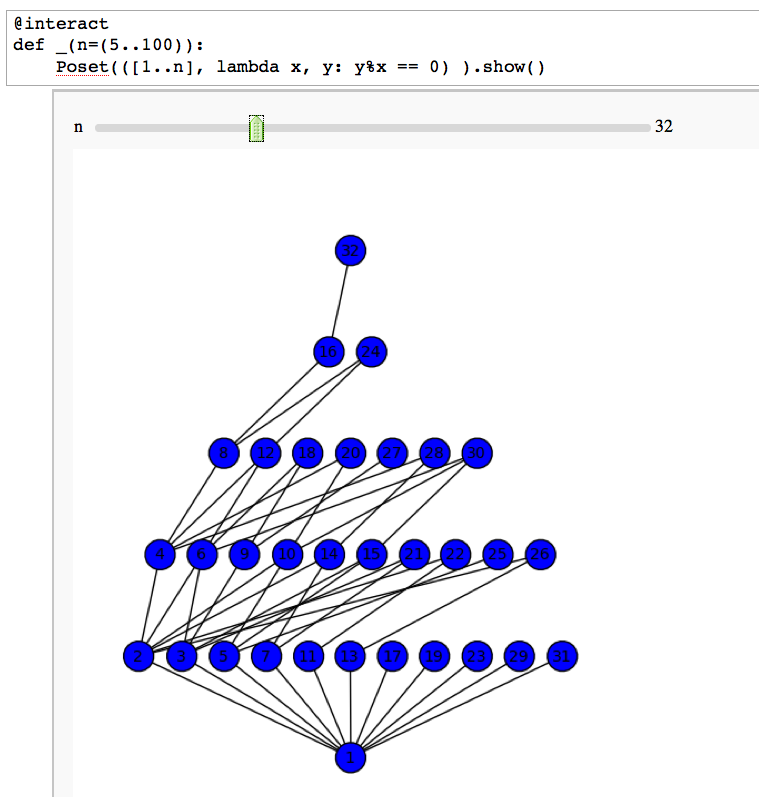
Factor Trees
by William Stein
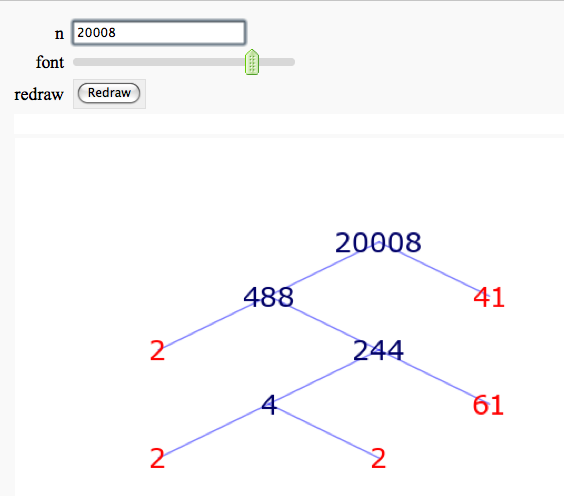
More complicated demonstration using Mathematica: http://demonstrations.wolfram.com/FactorTrees/
Factoring an Integer
by Timothy Clemans
Sage implementation of the Mathematica demonstration of the same name. http://demonstrations.wolfram.com/FactoringAnInteger/
Prime Numbers
Illustrating the prime number theorem
by William Stein
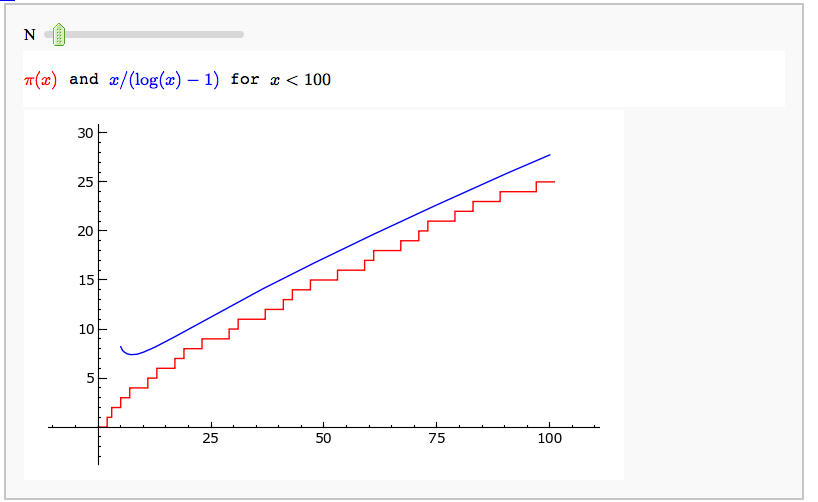
Prime Spiral - Square FIXME
by David Runde
Prime Spiral - Polar
by David Runde
Modular Forms
Computing modular forms
by William Stein
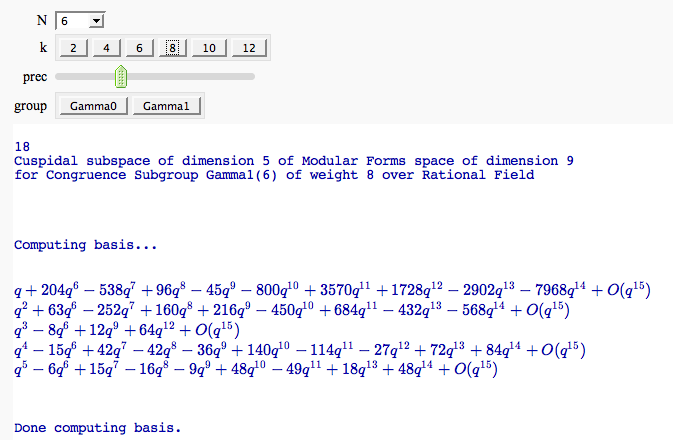
Computing the cuspidal subgroup
by William Stein
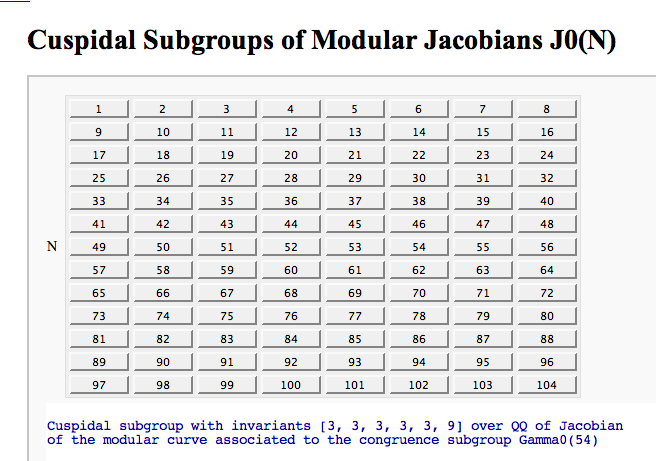
A Charpoly and Hecke Operator Graph
by William Stein
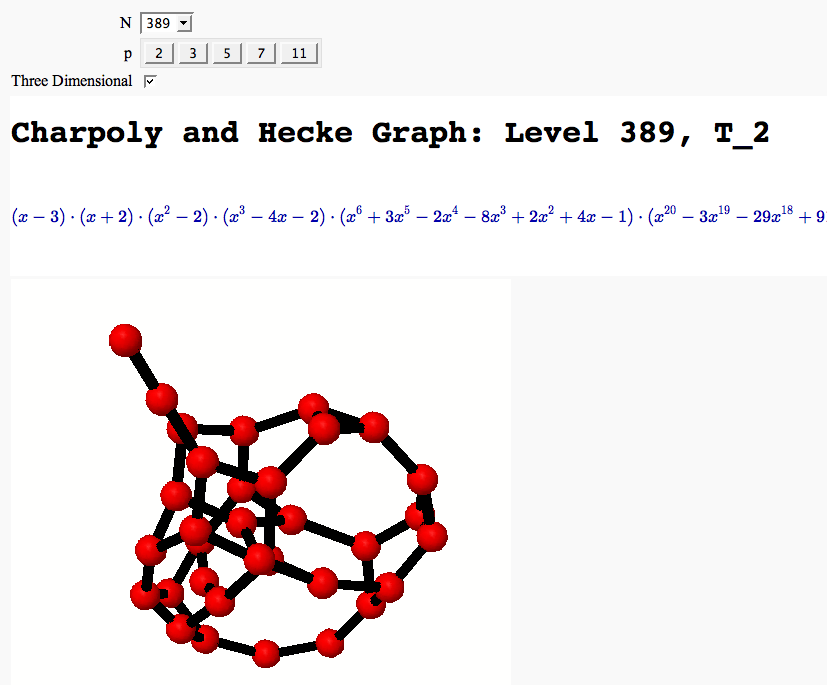
Modular Arithmetic
Quadratic Residue Table FIXME
by Emily Kirkman
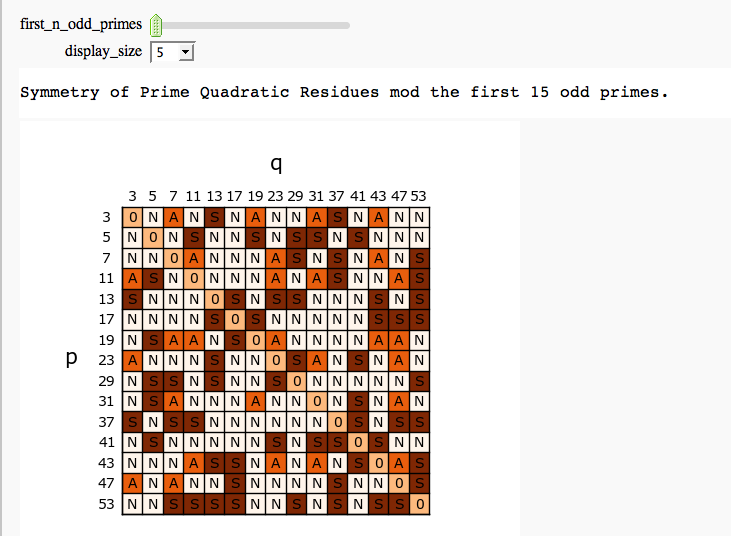
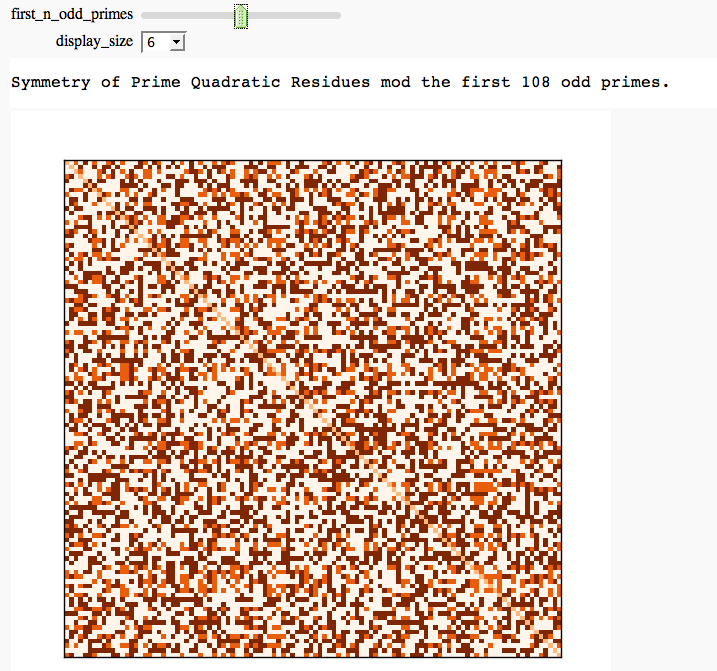
Cubic Residue Table FIXME
by Emily Kirkman
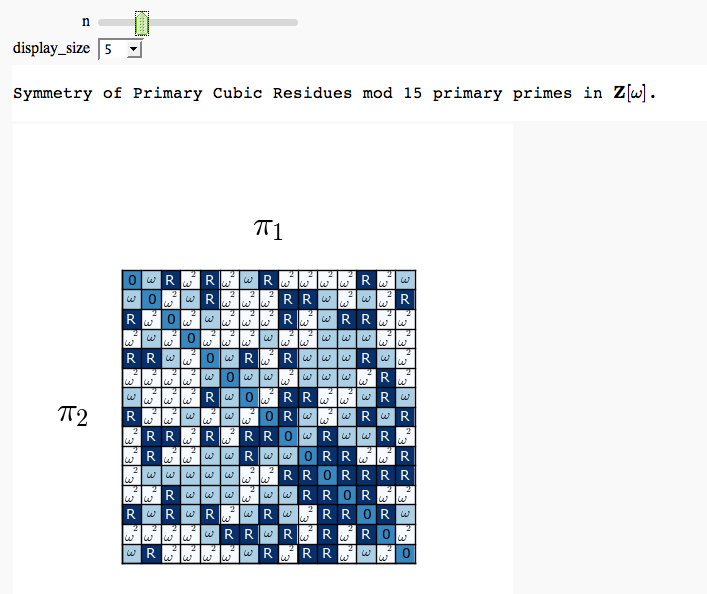
Cyclotomic Fields
Gauss and Jacobi Sums in Complex Plane
by Emily Kirkman
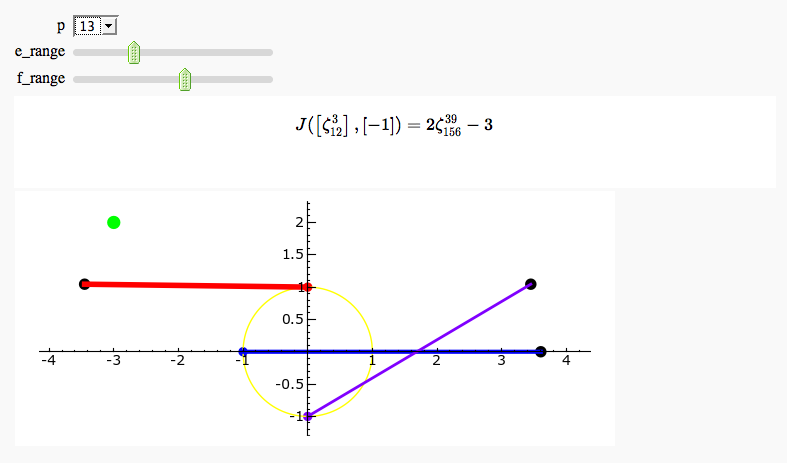
Exhaustive Jacobi Plotter
by Emily Kirkman
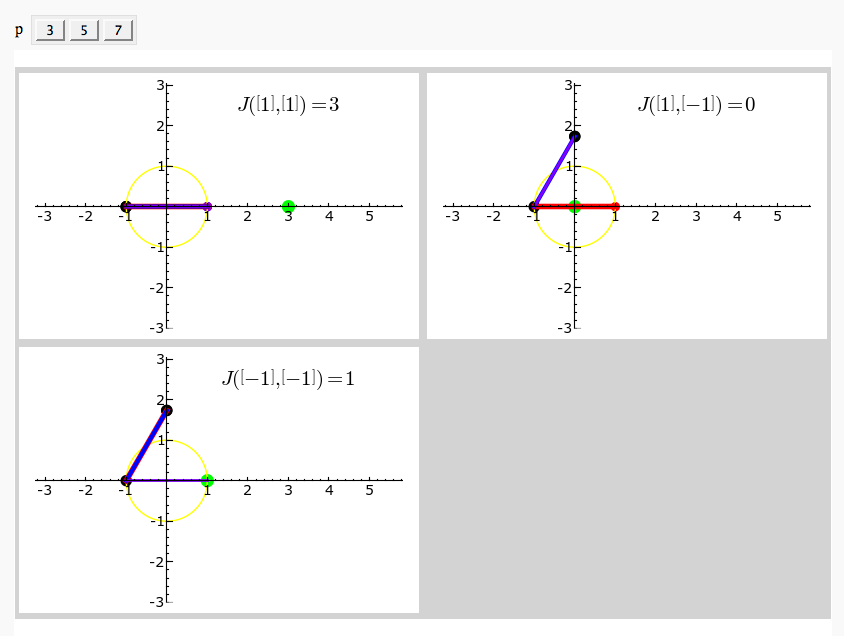
Elliptic Curves
Adding points on an elliptic curve
by David Møller Hansen
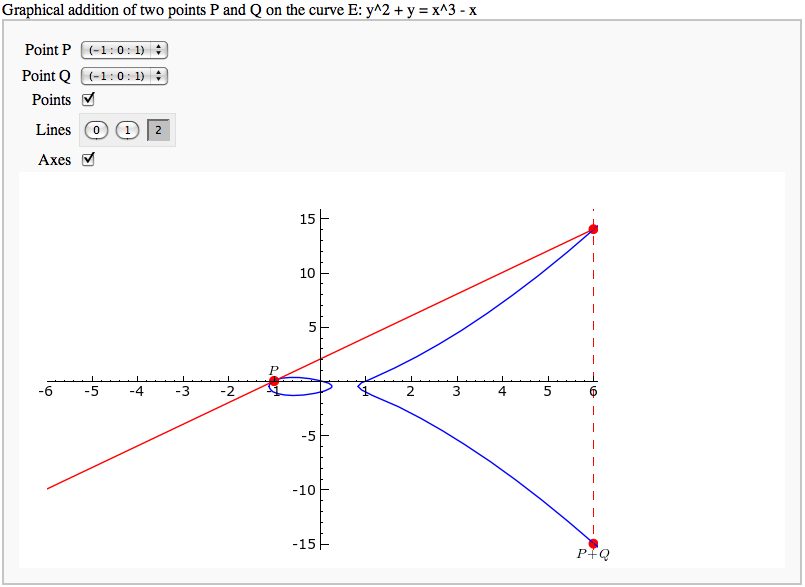
Plotting an elliptic curve over a finite field
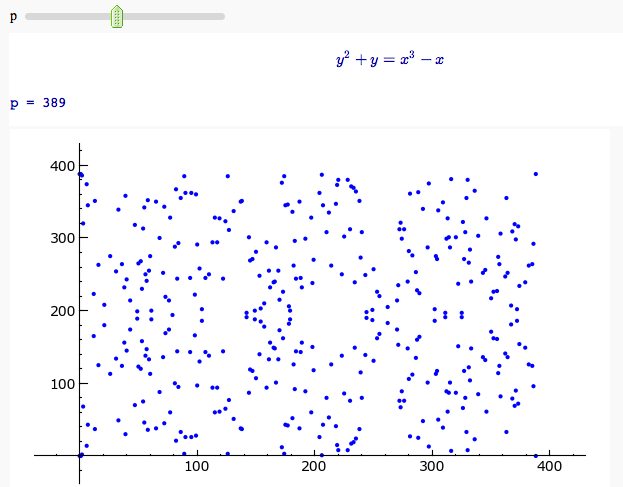
Cryptography
The Diffie-Hellman Key Exchange Protocol
by Timothy Clemans and William Stein
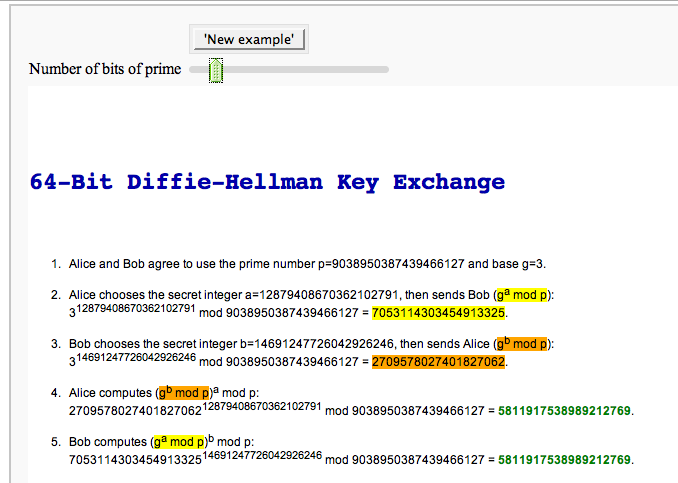
Other
Continued Fraction Plotter
by William Stein
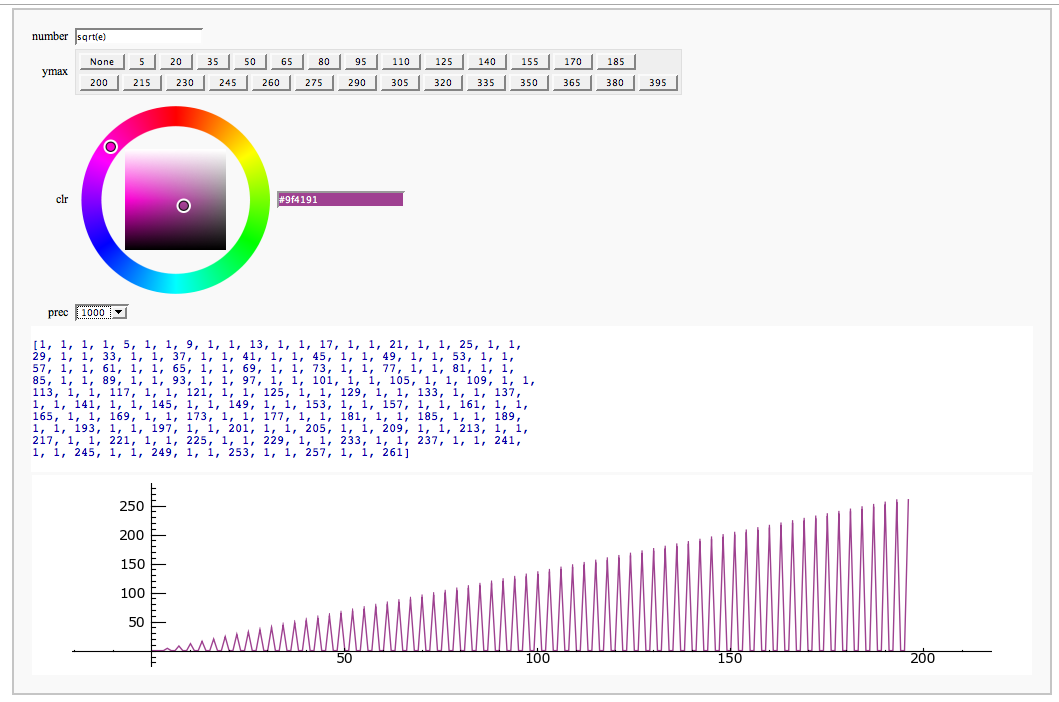
Computing Generalized Bernoulli Numbers
by William Stein (Sage-2.10.3)
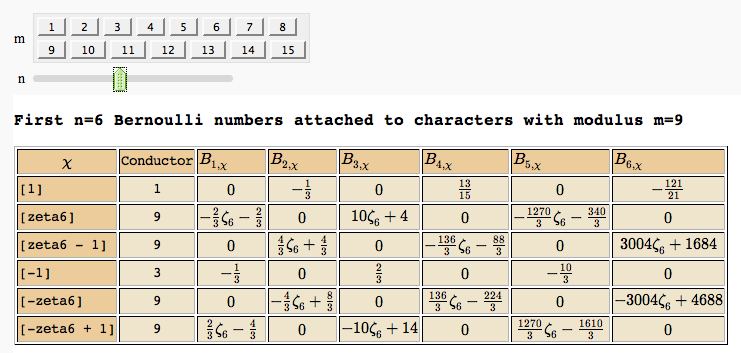
Fundamental Domains of SL_2(ZZ)
by Robert Miller
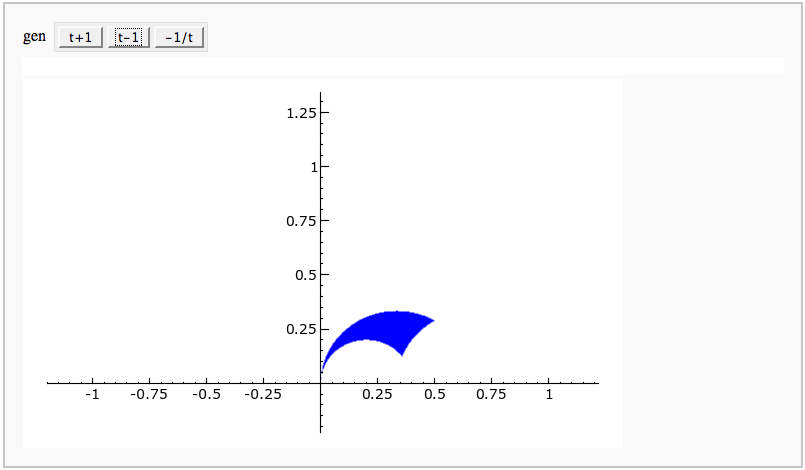
Multiple Zeta Values
by Akhilesh P.
Computing Multiple Zeta values
Word Input

Composition Input

Program to Compute Integer Relation between Multiple Zeta Values

Word to composition

Composition to Word

Dual of a Word

Shuffle product of two Words

Shuffle Regularization at 0

Shuffle Regularization at 1

